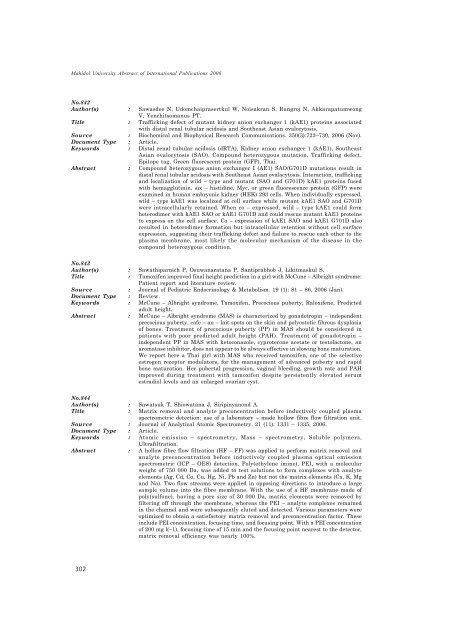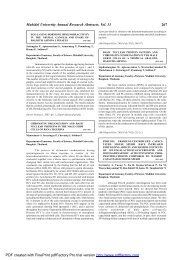2006 ที่น้องแอนทำ.pmd - Mahidol University
2006 ที่น้องแอนทำ.pmd - Mahidol University
2006 ที่น้องแอนทำ.pmd - Mahidol University
You also want an ePaper? Increase the reach of your titles
YUMPU automatically turns print PDFs into web optimized ePapers that Google loves.
<strong>Mahidol</strong> <strong>University</strong> Abstract of International Publications <strong>2006</strong><br />
No.842<br />
Author(s) : Sawasdee N, Udomchaiprasertkul W, Noisakran S, Rungroj N, Akkarapatumwong<br />
V, Yenchitsomanus PT.<br />
Title : Trafficking defect of mutant kidney anion exchanger 1 (kAE1) proteins associated<br />
with distal renal tubular acidosis and Southeast Asian ovalocytosis.<br />
Source : Biochemical and Biophysical Research Communications. 350(3):723–730, <strong>2006</strong> (Nov).<br />
Document Type : Article.<br />
Keywords : Distal renal tubular acidosis (dRTA), Kidney anion exchanger 1 (kAE1), Southeast<br />
Asian ovalocytosis (SAO), Compound heterozygous mutation, Trafficking defect,<br />
Epitope tag, Green fluorescent protein (GFP), Thai.<br />
Abstract : Compound heterozygous anion exchanger I (AE1) SAO/G701D mutations result in<br />
distal renal tubular acidosis with Southeast Asian ovalocytosis. Interaction, trafficking<br />
and localization of wild – type and mutant (SAO and G701D) kAE1 proteins fused<br />
with hemagglutinin, six – histidine, Myc, or green fluorescence protein (GFP) were<br />
examined in human embryonic kidney (HEK) 293 cells. When individually expressed,<br />
wild – type kAE1 was localized at cell surface while mutant kAE1 SAO and G701D<br />
were intracellularly retained. When co – expressed, wild – type kAE1 could form<br />
heterodimer with kAE1 SAO or kAE1 G701D and could rescue mutant kAE1 proteins<br />
to express on the cell surface. Co – expression of kAE1 SAO and kAE1 G701D also<br />
resulted in heterodimer formation but intracellular retention without cell surface<br />
expression, suggesting their trafficking defect and failure to rescue each other to the<br />
plasma membrane, most likely the molecular mechanism of the disease in the<br />
compound heterozygous condition.<br />
No.843<br />
Author(s) : Sawathiparnich P, Osuwanaratana P, Santiprabhob J, Likitmaskul S.<br />
Title : Tamoxifen improved final height prediction in a girl with McCune – Albright syndrome:<br />
Patient report and literature review.<br />
Source : Journal of Pediatric Endocrinology & Metabolism. 19 (1): 81 – 86, <strong>2006</strong> (Jan).<br />
Document Type : Review.<br />
Keywords : McCune – Albright syndrome, Tamoxifen, Precocious puberty, Raloxifene, Predicted<br />
adult height.<br />
Abstract : McCune – Albright syndrome (MAS) is characterized by gonadotropin – independent<br />
precocious puberty, cafe – au – lait spots on the skin and polyostotic fibrous dysplasia<br />
of bones. Treatment of precocious puberty (PP) in MAS should be considered in<br />
patients with poor predicted adult height (PAH). Treatment of gonadotropin –<br />
independent PP in MAS with ketoconazole, cyproterone acetate or testolactone, an<br />
aromatase inhibitor, does not appear to be always effective in slowing bone maturation.<br />
We report here a Thai girl with MAS who received tamoxifen, one of the selective<br />
estrogen receptor modulators, for the management of advanced puberty and rapid<br />
bone maturation. Her pubertal progression, vaginal bleeding, growth rate and PAH<br />
improved during treatment with tamoxifen despite persistently elevated serum<br />
estradiol levels and an enlarged ovarian cyst.<br />
No.844<br />
Author(s) : Sawatsuk T, Shiowatana J, Siripinyanond A.<br />
Title : Matrix removal and analyte preconcentration before inductively coupled plasma<br />
spectrometric detection: use of a laboratory – made hollow fibre flow filtration unit.<br />
Source : Journal of Analytical Atomic Spectrometry. 21 (11): 1331 – 1335, <strong>2006</strong>.<br />
Document Type : Article.<br />
Keywords : Atomic emission – spectrometry, Mass – spectrometry, Soluble polymers,<br />
Ultrafiltration.<br />
Abstract : A hollow fibre flow filtration (HF – FF) was applied to perform matrix removal and<br />
analyte preconcentration before inductively coupled plasma optical emission<br />
spectrometric (ICP – OES) detection. Poly(ethylene imine), PEI, with a molecular<br />
weight of 750 000 Da, was added to test solutions to form complexes with analyte<br />
elements (Ag, Cd, Co, Cu, Hg, Ni, Pb and Zn) but not the matrix elements (Ca, K, Mg<br />
and Na). Two flow streams were applied in opposing directions to introduce a large<br />
sample volume into the fibre membrane. With the use of a HF membrane made of<br />
poly(sulfone), having a pore size of 30 000 Da, matrix elements were removed by<br />
filtering off through the membrane, whereas the PEI – analyte complexes remained<br />
in the channel and were subsequently eluted and detected. Various parameters were<br />
optimized to obtain a satisfactory matrix removal and preconcentration factor. These<br />
include PEI concentration, focusing time, and focusing point. With a PEI concentration<br />
of 200 mg l(–1), focusing time of 15 min and the focusing point nearest to the detector,<br />
matrix removal efficiency was nearly 100%.<br />
302
















